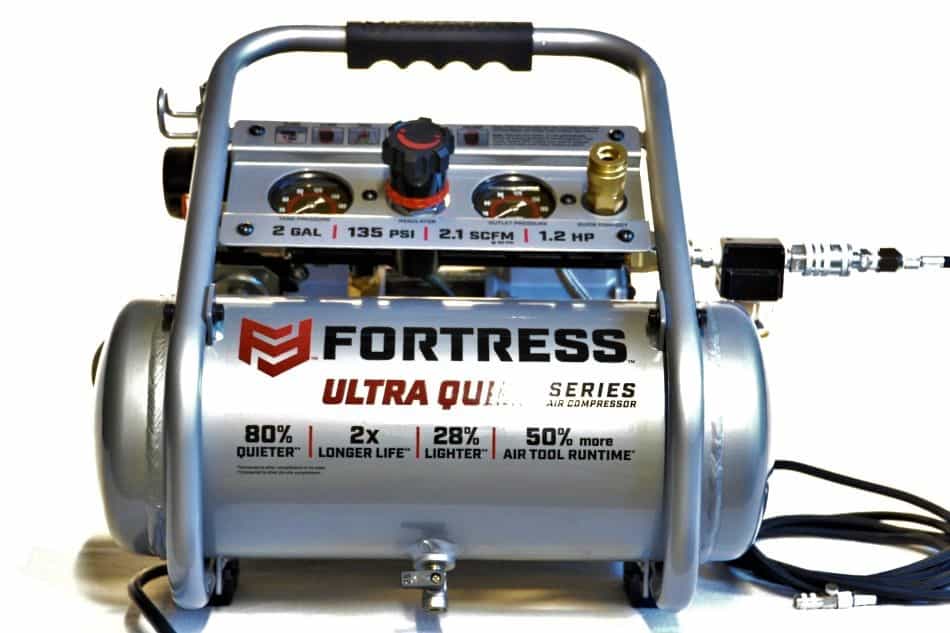When it comes to choosing an airbrush compressor, one of the largest questions many have is: Should I go with an air compressor equipped with a tank, or go tankless?
I too wondered which direction to go when I was in search of my first airbrush compressor, long ago. But after a little research, I quickly came to the conclusion that a compressor is going to last longer if it’s equipped with a tank.
Simply because a tank essentially allows a compressor to take rest periods between tank fill-ups. This means the compressor motor won’t have to run the entire time your airbrushing. Hence less wear on the motor…
But depending on how often you intend on using the compressor, a tank may not be as important to you as it was me.
You see, my intended use is to airbrush large photo realistic paintings using my airbrush. To which will require a lot out of an airbrush compressor (many hours of paint time), but with an air supply tank it takes a lot of stress off the compressor motor, as it is able to take breaks between refills.
So, in short
I wouldn’t say you need a tank for your airbrush compressor. But a tank will likely improve your work, and increase the life of the compressor, as the motor won’t have to work the entire time you airbrush.
Advantages Of A Compressor Supply Tank When Airbrushing
Consistent Air Flow
Airbrush air compressors that are not equipped with an air storage tank are said to cause an issue with pulsing. pulsing simply refers to the compressed air passing through the air lines and out the tip of the airbrush in a sporadic manner, rather than a smooth flow of air.
This pulsing is said to occur due to the method at which the compressor builds up air pressure. Typically done using a piston.
Each time the piston rises the air is pressurized, but when it falls it pulls outside air in to the chamber to be pressurized when the piston goes back up. This motion can cause what is known as Pulsing of the air as it flows through the air hose and out the airbrush.
This causes an Issue when airbrushing because it is as if someone is turning the air off and on very quickly. Creating a sputtering effect that will cause an inconsistent spray pattern.
But of course this pulsing effect happens so quickly its difficult to tell.
However, when the air compressor is equipped with a pressure storage tank, the pulsing of the compressor ends once the air inside the tank is at a greater pressure then that which you are using.
This is because, now (with a tank) the airbrush has a built up store of air that it can draw from, instead of drawing it directly from the compressor motor (as done with a tankless compressor).
Quick Analogy,
Think of it like drinking a beverage using a straw. Compare the tankless air compressor to drinking from a straw and getting air bubbles due to the liquid supply being short (Cup is nearly empty).
And a compressor with a tank, to drinking from a full cup with the straw completely submerged. You get no air bubbles through the straw as you have an adequate supply to drink from. And once the supply gets low (in this analogy) the compressor will power back on and refill the tank to the max PSI.
Simply put, instead of pulling compressed air directly from the compressor motor, you are pulling it from a supply of pre compressed air. This completely eliminates any possible pulsing that could occur. Assuming you have a storage tank that is large enough.
Longer Lasting
With no doubt, an air compressor that is equipped with a storage tank will out last a compressor without a tank. This is because, the compressor with the tank is working maybe half the amount of time the tankless compressor is working.
A tank will allow the compressor to take breaks between re fills.
It works like this,
A Tankless compressor is forced to work the entire time you are drawing air from it.
Where as the compressor with a tank is only forced to work when the air supply in the tank falls below a specific point (Ex: 50 PSI). Then it will shut back off once it reaches its max capacity (Ex: 125 PSI).
The ability to stop running will drastically help a compressor to last much longer, and nearly eliminate the possibility of the compressor overheating (Assuming your tank is large enough to handle the draw you need).
Simply put, the most impactful factor here is heat buildup. As you likely know motors build up heat due to friction. The longer a motor runs the hotter it is going to get (Assuming it doesn’t have a good cooling system, Which for the most part compressors don’t). And by forcing a compressor to work continuously for a few hours its going to build up a lot of heat, which could potentially damage the compressor for good…
But by using a tank the compressor can take brakes, and cool down between re-fills of the tank.
Break From The Noise
Leading on from the previous advantage. When a compressor is allowed to stop working after a re-fill, you also get a break from the noise. Where as tankless compressors will just continually run until you stop airbrushing.
Which can get kinda annoying after a while. Even if the compressor is fairly quiet.
A tank will allow the compressor to stop working even while you continue airbrushing. Then it will kick back on once the air supply in the tank falls below a specific point.
But do note, the larger the air supply tank, the longer you will be able to airbrush between re fills. Meaning the longer period of time you will have before the compressor kicks back on and fills the silence.
That being said,
The compressor I currently use is actually very quiet to begin with so noise isn’t much of an issue even when its running. But with the 2 gal tank it came with, I’m able to airbrush for around 5 Minutes (Continuously @ 40PSI) before the compressor kicks back on to refill the tank.
Aw Yeah, 5 minutes of silence with 30 seconds of noise to refill the tank. Then back to the silence.
But I must note, the compressor I use isn’t specified as an airbrush compressor. Turns out airbrush labeled compressors aren’t typically the best option for airbrush use, especially if you intend on airbrushing for an extensive amount of time (Few hours Plus).
Haha, who would have thought…
If you’d like to learn about the compressor I use, be sure to check out my compressor recommendation page.
Disadvantages Of A Compressor Supply Tank When Airbrushing
Though It is ideal to have a tank on an airbrush compressor. There are some disadvantages to be aware of. But, assuming you airbrush like the majority of airbrush artists out their, these shouldn’t be to big of a deal. But do consider your own situation.
Added Weight
Compressors with a tank are going to weigh a little more than tankless compressors. Simply because there is more components involved (The tank). But for the most part, a compressor tank isn’t going to increase the weight much. maybe by a couple pounds (depending on the material used to make the tank).
Rather the next is going to be more impactful.
Greater Size
Its common to see airbrush compressors equipped with a 1 gal – 2 gal tank. But a 2 gal tank can be near to the size of a basketball. That is if it was stretched out like a hot dog… But you get the Idea.
A compressor with a tank is likely going to be 2 to 3 times the size of a tankless compressor. But again, as long as you have the space this shouldn’t be much of an issue. And it will be well worth the added space consumption.
Conclusion
In final, A compressor with a tank is the best way to go in my opinion. I wouldn’t even bother with the tankless compressors if you intend on doing a lot of airbrush work. Though if your only looking to airbrush every now and then, then a tank may not be so necessary.
Granted, a tank will improve your setup & workflow (Assuming you have a 2 gal tank or more), I’m almost certain of it. You just get so many advantages with a compressor equipped with a tank vs tankless.
If your in the market for an air compressor ideal for airbrush use, I always recommend people to opt for a compressor with a supply tank. As the benefits far out weight that of a tankless compressor. That is if a tankless compressor had much for benefits when compared to a compressor equipped with a tank.
For a compressor recommendation, do be sure to Check out my #1 recommended compressor for airbrush use… I have spent countless hours researching compressors that are quiet, reliable, and cost efficient.
Anyway, I hope you were able to find some value here! If you have any further questions regarding the airbrush do be sure to take a look around the website. Airbrush Insider is dedicated to helping all in the airbrush community!
This is Colt signing off!
Check Out Some Of My Favorite Airbrush Equipment:

